Gone are the days of solely relying on keywords to drive your PPC success.
With the relaxed keyword match types, the use of audiences in Google Ads has sophisticated tenfold.
Utilizing audience targeting is no longer an option for campaigns; it should be part of your overall campaign strategy.
Here, you’ll learn four advanced audience targeting tactics for refining your PPC targeting to leverage budget and maximize return on ad spend (ROAS).
1. Smarter Use Of Remarketing Lists For Search Ads (RLSAs)
Remarketing lists for search ads (RLSAs) allow you to customize your search ad campaigns based on the user behavior of previous website visitors, and tailor your bids/targeting options around these users when they’re searching on Google.
Example: Target people who spend over your average purchase revenue when searching for competitor brands.
This tactic will allow you to target and display ads to users that have generated a high conversion value for you historically whenever they are searching for one of your competitors on Google search, which could help you avoid losing customers to your paid competitors.
For example, an online grocery retailer could identify shoppers who spend over their average order value each week.
In this scenario, the advertiser could set up a separate campaign to target and bid on competitor terms but use RLSAs so that ads are only served whenever users within the list are searching.
This is a great way of ensuring your budget is only spent on retaining profitable customers.
If you’d like to apply this tactic to your account, you’ll first need to find the average purchase revenue per user being reported in your Google Analytics account by navigating to Monetization > Overview:
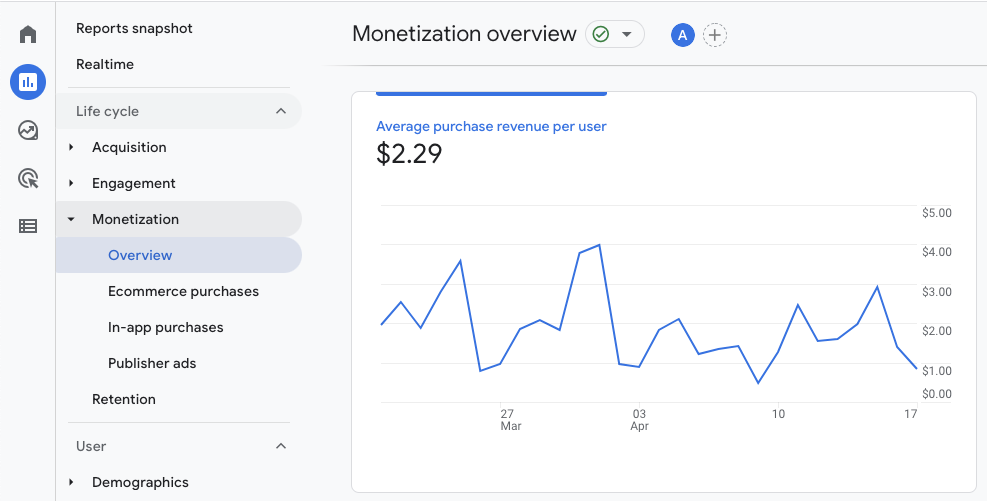 Screenshot by author, March 2022
Screenshot by author, March 2022Once you’ve found the average order value figure you’ll be able to create an audience list using the audience builder via Configure > Audiences in Google Analytics:
 Screenshot by author, March 2022
Screenshot by author, March 2022You can set the event parameters and add any conditions:
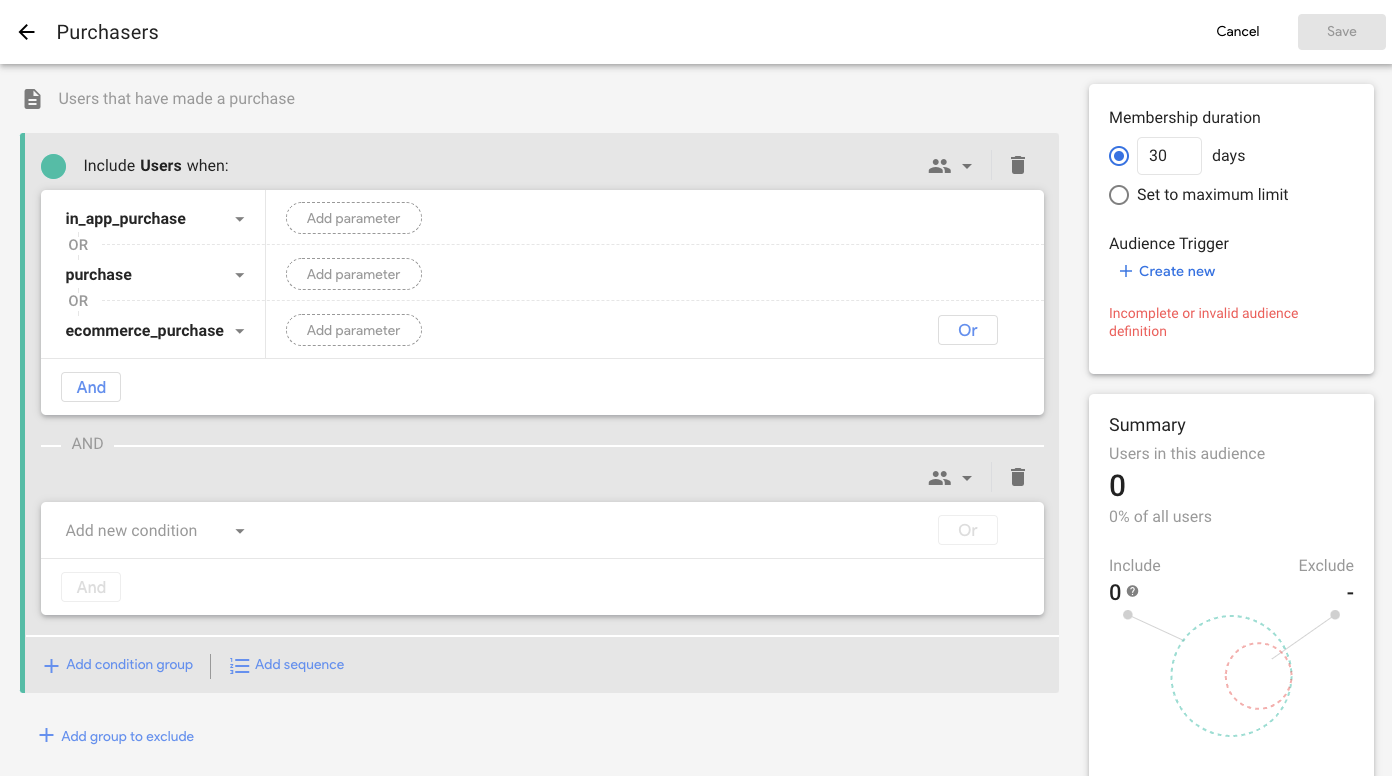 Screenshot by author, March 2022
Screenshot by author, March 2022This tactic is particularly effective in industries where consumers aren’t loyal and may often flick between different retailers for the best deal (e.g., in grocery retail).
By applying this list you could tailor your ad copy and advertise loyalty discounts to these customers to prevent them from deserting your brand for a competitor:
 Screenshot by author, March 2022
Screenshot by author, March 20222. Combining Social Audiences With RLSAs
With more than 2.9 billion monthly active users, Facebook has no rival when it comes to the enormity of its audience.
While Facebook targeting can be beneficial to reach the masses, another main benefit Facebook offers lies in the potential granularity with which you can target Facebook’s users.
Unlike Google Ads, Facebook has information on what users actually “Like” or follow, and in-depth data from users’ personal profiles.
The benefits of using social ads alongside search campaigns can be huge.
For example, a recent case study from Facebook showed that the brand Bombas saw a 27-point lift in ad recall for evergreen campaigns when utilizing Custom Audience targeting.
Despite this, I still encounter tons of brands whose approach to advertising on both Facebook and Google is unaligned, and therefore they fail to share insights gained from one platform to another to maximize success.
Example: Use Facebook to uncover new potential buyers and then target these people on search to increase the likelihood of them converting.
Facebook is one of the best platforms for expanding your reach and identifying new users who aren’t actively looking for your products or services right now.
By tagging the ads you run on Facebook targeting these new audience segments, you will later be able to target ads at these users when they search Google using top-of-the-funnel keywords, increasing the likelihood of those Facebook clicks turning into new customers.
To do this, you would first need to create a new campaign on Facebook designed to target new potential customers you aren’t already targeting with your search ads (exclude existing website visitors and mailing list members):
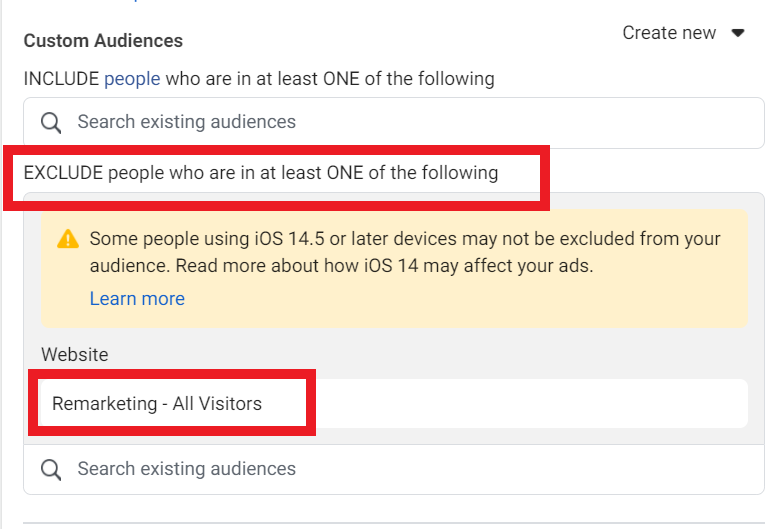 Screenshot by author, March 2022
Screenshot by author, March 2022By tagging the resulting Facebook campaign with UTM tags, any clicks from this audience will be recorded in Google Analytics under the campaign name you have set.
You’ll then be able to create an audience list in Google Analytics which consists of traffic from this particular Facebook campaign:
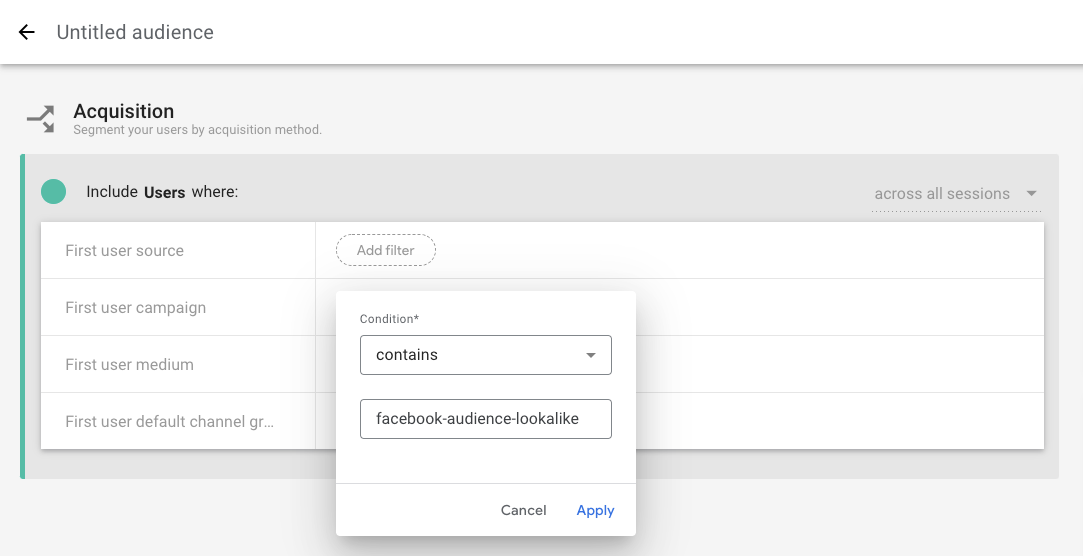 Screenshot by author, March 2022
Screenshot by author, March 2022Remember, like any audience list you create, the list must contain at least 1,000 members before being eligible for use on Google search.
Once you’ve populated your audience list with enough traffic from Facebook, create a search campaign on Google Ads which includes only top of the funnel keywords such as informational queries related to the product/service you offer (they need to be top of the funnel because this audience isn’t specifically searching for your product/service).
Finally, apply the remarketing list to the ad groups created in your search campaign, choosing the target and bid setting, so that the search ads only show to users who are from your list of new potential customers uncovered on Facebook.
I strongly recommend this tactic if you feel like you have exhausted current demand on Google search in your industry, as it allows you to effectively create search demand by reaching new users and promoting consideration of your product or service.
You can also utilize this same strategy using Microsoft Ads to maximize your reach.
3. Using Custom Affinity Audiences
Google launched custom affinity audiences to give advertisers more granular control over audience targeting options on the display network.
This tackles the issue with regular Google Ads affinity audiences in that there isn’t a predefined affinity audience suitable for every business.
Custom affinity audience targeting can be set up by navigating to a Display campaign in Google Ads, clicking Targeting > Audience Segments > Your Custom Audience Segments > New Custom Audience.
Here you can create your own specific audience using free form interests entered as keywords and/or using URLs as a proxy for interest bundles:
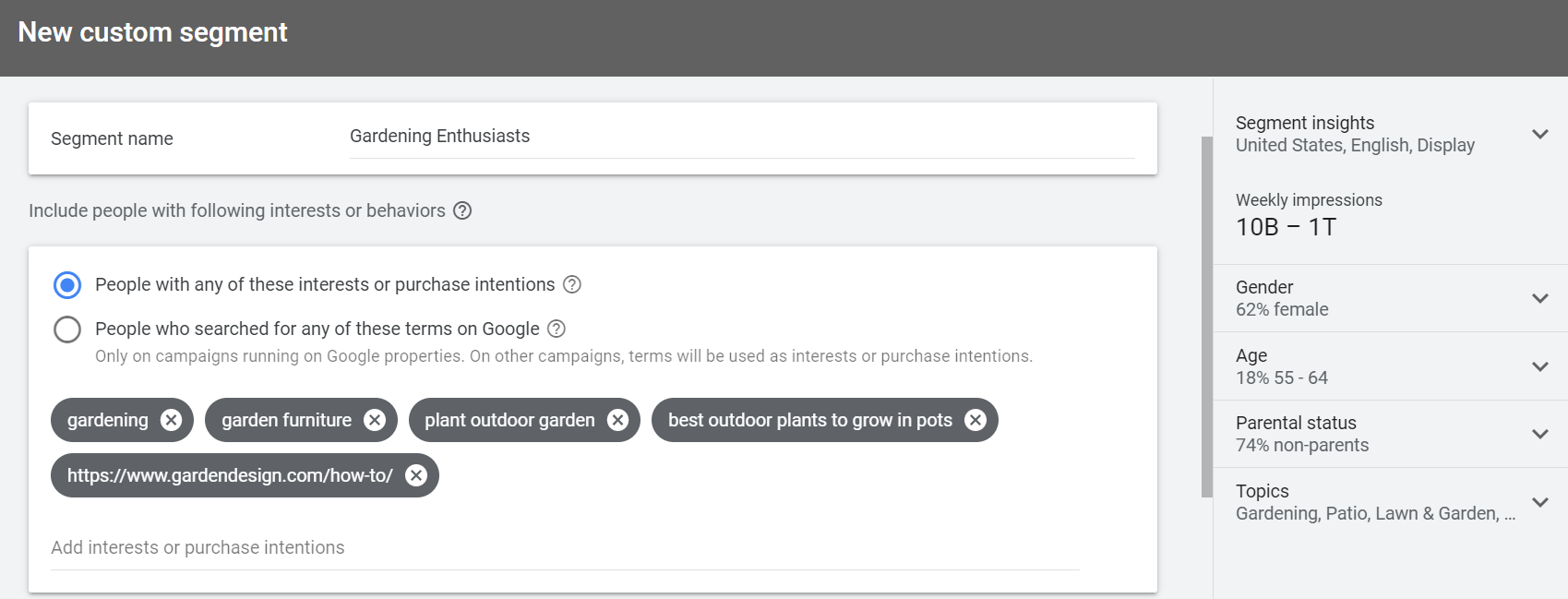 Screenshot by author, March 2022
Screenshot by author, March 2022In this example, the custom affinity targeting has built an audience of “Garden Enthusiasts” using interests (keywords entered) and URL targeting.
You’re able to get real-time demographic insights as you’re building the audience. This can help drive further granularity to ensure you’re targeting the right people.
While custom affinity audience targeting allows for more control on the GDN, I think it’s best used for brand building.
You can take an even more granular approach to GDN targeting by layering custom affinity audiences with other forms of targeting to increase campaign efficiency.
4. Combining In-Market Segments With Remarketing
In-market audiences allow you to set up your campaigns to reach people who are further down the funnel and are more ready to make a purchase.
Google accurately categorizes users so you can target those most interested in their offerings.
Google states that you can distinguish interest from the purchaser’s intent by leveraging real-time data and a powerful classification system based on demonstrated in-market behavior.
In-market audiences can help drive incremental conversions, helping you to connect with consumers as the last step before they make a purchase decision.
To target an in-market audience segment you would need to navigate to Targeting > In-market and life events > In-market segments.
Here you will see a list of almost 500 available in-market audiences, with the option to further granulate the high-level categories (highlighted below).
Simply click the “down” arrow on each In-Market category to drill down your desired audience.
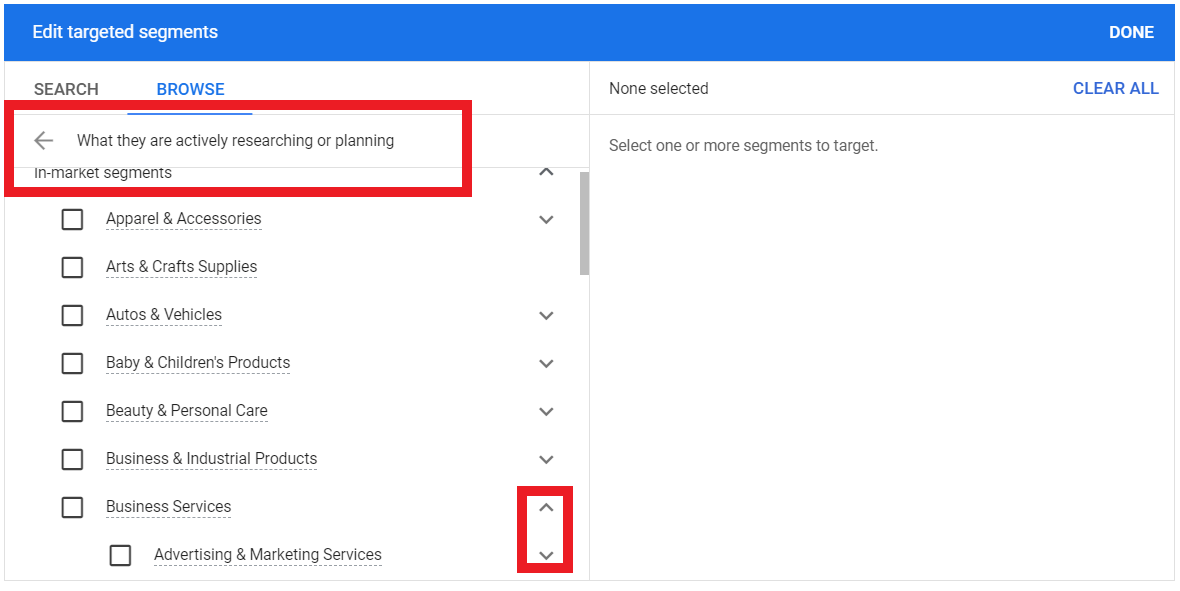 Screenshot by author, March 2022
Screenshot by author, March 2022The real impact on conversions comes when using in-market segments in conjunction with website remarketing lists.
You can layer the in-market segments on top of your remarketing lists to increase reach while maintaining a high degree of relevancy with the aim of bolstering overall conversions.
Conclusion
Paid search keyword costs continue to rise every year. If your marketing budget doesn’t increase to keep up with the shift, you’ll need to get creative to drive new demand growth.
Many advertisers are shifting huge chunks of the budget over to other platforms such as Facebook, Snapchat, and TikTok, largely due to superior audience targeting options (not searcher intent) and reduced CPCs.
With this in mind and the increased use of automation within Google Ads, I think Google will be continuing to add to its options of audience targeting in a privacy-centric way.
The PPC landscape is always changing. Make sure you keep on top of the latest features as well as test some of the tips outlined above to see whether they can deliver improved paid media results for your business.
More Resources:
- Remarketing Playbook: 8 Types of Remarketing You Should Be Doing
- How to Launch Your First Google Ads Remarketing Campaign
- PPC 101: A Complete Guide to PPC Marketing Basics
Featured Image: Jirsak/Shutterstock





